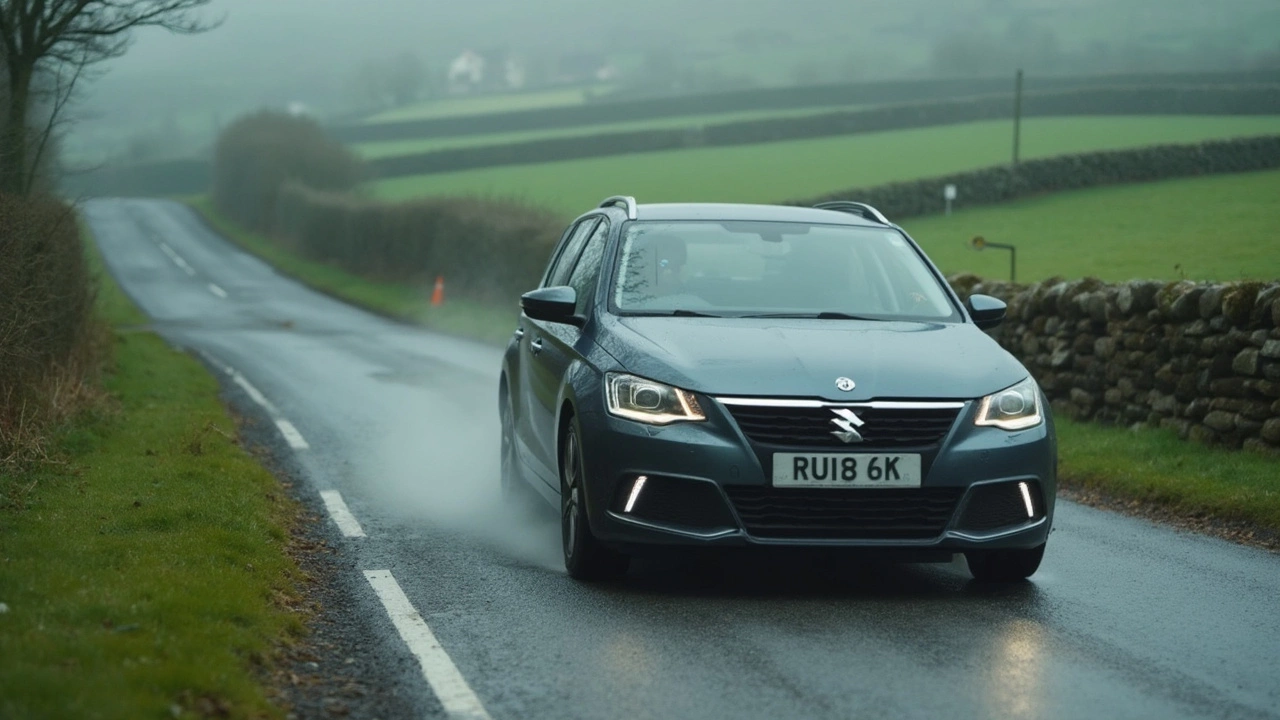Got squeaky brakes or that warning light flickering on your dash? That's your car basically yelling, "Hey, check my brake pads!" If you're thinking about squeezing out a few more miles before making time for a repair, you’re not alone. But putting it off isn’t just about annoying noises—it could mess up your day or even put you in a dangerous spot.
Brake pads are honestly your last line of defense between stopping safely and rolling through a red light. They press against your brake rotors to slow your wheels. When they wear thin, stopping takes longer. That’s not something you want to gamble with on a busy road or slick pavement.
Waiting too long isn’t just a safety issue—it gets expensive fast. Damaged rotors, calipers, and even the whole brake system can add up on your repair bill if you keep pushing it with bad pads. There’s no “safe” number of miles for driving on worn-out pads. It really depends on how thin they are and how you drive. Want to avoid a sketchy emergency stop and a giant mechanics bill? Getting on top of this one early is way better than waiting for a grinding noise to scare you into the shop.
- What Happens When Brake Pads Wear Out?
- How to Spot Worn Brake Pads
- Risks of Driving on Bad Brake Pads
- When Is It Safe (or Not) to Drive?
- Smart Tips to Keep Your Brakes in Shape
What Happens When Brake Pads Wear Out?
If you let brake pads wear down too far, a few things start happening—and none of them are good. First off, your stopping distance gets longer. That means you’ll need more room to slow down or stop, and that’s risky, especially in traffic or rainy weather.
The noise is another sign. Worn brake pads start screeching or making a grinding sound because the pad material is gone, and now you’ve got metal scraping metal. Ignoring those sounds doesn’t just make your car annoying to be around; it means you’re probably hurting your rotors with every stop, making repairs a lot more expensive.
- Heat builds up a lot faster with almost no pad material left, which can literally warp your rotors.
- Your car’s warning lights (ABS or brake warning) might come on.
- The brake pedal can start to feel soft or shaky because of extra heat and uneven surfaces inside your brake system.
Check this out: a test by a major auto repair network in the U.S. showed that worn pads can bump your stopping distance from 60 mph by over 30 feet. That’s like blowing past an intersection before you finally stop.
| Pad Thickness | Risk Level | Stopping Distance Change |
|---|---|---|
| Over 6mm | Low | Normal |
| 3-4mm | Medium | +10-20 feet |
| Less than 2mm | High | +30 feet or more |
Letting brake pads go past their limit can even lead to total brake failure. It’s one of those things people regret ignoring—usually right after a close call or a surprise repair bill. The fix is simple if you catch it early. Wait too long, and you’ll pay way more in both money and stress.
How to Spot Worn Brake Pads
Not sure if your brake pads are good or nearly shot? Here’s what to keep an eye (and ear) out for, because missing the signs can mean bigger trouble down the road.
- Squeaking or squealing sounds: If you hear a high-pitched noise when you tap the brakes, that’s usually the wear indicator—a little metal tab—rubbing against the rotor. It’s basically your car’s way of saying, “Replace my pads soon!”
- Grinding noise: If it sounds like metal on metal, you’re way past due. The brake pads may be completely worn down and you’re chewing up your rotors. Don’t drive like this unless you’re literally rolling into the mechanic’s parking lot.
- Dashboard warning lights: Some cars—especially newer ones—have a brake warning light that flips on when your pads get too thin. Don’t ignore this.
- More pedal travel: If your brake pedal feels "softer" than usual, or you have to push it farther, your pads might be thinning out.
- Visual inspection: Peek through the wheel spokes if you can. If you see less than 3mm (about 1/8 inch) of pad left, get them swapped out soon. Some shops say to change them at 4mm or less just to be safe.
Want it laid out with some quick reference numbers and facts? Here’s a handy table:
| Warning Sign | What It Means | What to Do |
|---|---|---|
| Squealing noise | Wear indicator hitting rotor | Plan for a replacement in the next week or two |
| Grinding sound | No pad left, metal on metal | Get to a shop immediately |
| Thin pads (<3mm) | Visual sign of wear | Replace them ASAP |
| Brake warning light | Sensor triggered, low pads | Check pads, replace soon |
Don’t rely on guessing—taking a couple minutes to spot these things can save your wallet and keep you safe. Driving safety is a lot easier when you catch these small warnings early.

Risks of Driving on Bad Brake Pads
Driving on worn-out brake pads is just asking for trouble. First off, your stopping distance goes up—sometimes by more than you’d think. This means if someone slams their brakes in front of you, your car might not stop in time, and you could end up rear-ending them. In fact, even losing just a couple millimeters of pad thickness can increase your stopping distance by several feet.
It’s not just about accidents, either. Worn brake pads force the metal parts behind them—the calipers and rotors—to take the hit. This leads to warped rotors, chewed-up calipers, and the kind of damage that turns a $150 brake job into a $1,000 headache. The longer you go, the more other parts you risk screwing up.
Your car will also start to warn you in less obvious ways. That grinding noise? That’s metal scraping on metal. It’s literally the sound of money going down the drain. Some cars also trigger a dashboard warning or ABS light, which means your braking system’s getting less reliable by the day.
Besides repairs and safety, there’s a legal angle: in some areas, getting caught with faulty brake pads can earn you a ticket. After all, cops see your ride as a moving hazard. For folks who drive their families around, or even just care about avoiding nasty surprises, that risk just isn’t worth it.
- Increased risk of rear-end collisions and fender benders.
- Expensive damage to rotors and calipers if you wait too long.
- Dashboard warnings or squealing/grinding noises are not just for show—ignore them, and the repair bill jumps quickly.
- Legal trouble or car inspection fails in places where brake health is checked.
Check out this quick comparison to see how driving on bad pads stacks up:
| Brake Pad Condition | Stopping Distance (at 60 mph) | Average Repair Cost |
|---|---|---|
| Good (8mm+) | 135 ft | $150-$250 |
| Worn (<3mm) | 160+ ft | $500-$1200 (includes rotor/caliper) |
So yeah, that squeak isn’t just annoying—it’s your wallet and safety on the line. Those little pads might seem like no big deal until you’re suddenly facing a way bigger problem.
When Is It Safe (or Not) to Drive?
So, let’s get real. Is it ever actually safe to drive if you know you need new brake pads? The answer depends on how bad things are and what the warning signs look like. If your brakes only make a light squeak now and then, you're probably not in immediate danger, but you’re living on borrowed time. Once you hear loud grinding or the brake pedal starts feeling mushy, you’re past a safe zone—your stopping power is already cut down, and the damage stacks up fast.
For most cars, manufacturers say to replace brake pads when there’s less than 3mm left. Under that limit and you’re risking not just your car, but also everyone on the road. And if your brake warning light is on, don’t brush it off. That means the sensors have picked up action way before your ears do.
- If your brakes are squeaking but still responsive, keep trips short and avoid highways or heavy traffic until you can get them checked.
- If things get to grinding or the car pulls to one side, park it and call for help. You don’t want to mess with total brake failure.
- Every extra mile on worn brake pads means more parts could get trashed.
Here’s a quick look at how stopping distance changes when your brakes are worn out:
| Condition | Average Stopping Distance (60 mph to 0) |
|---|---|
| New Brake Pads | 120 ft |
| Worn Brake Pads | 160+ ft |
| Bad Pads & Damaged Rotors | 200+ ft, can double in wet weather |
It might still feel like your car is "fine" on a slow drive, but the difference in stopping distance can mean the world in an emergency. Bottom line? If you’re questioning if you should drive, that’s already your sign to get those brake pads looked at ASAP.

Smart Tips to Keep Your Brakes in Shape
If you want your brake pads and the rest of the stopping system to actually do their job, you’ve got to show them a little care. Brake problems almost never show up out of nowhere. Here’s how to stay on top of things and avoid those wallet-draining repairs.
- Check your pads regularly. Glance at your brake pads every few months if your wheels let you see them. If they look less than a quarter inch thick, it’s go-time for a new set.
- Don’t ignore weird noises. If you hear squealing or grinding, that’s usually the built-in wear indicator—or metal-on-metal if you’ve really waited too long. Either way, get it checked out immediately.
- Don’t ride the brakes. Avoid keeping your foot on the pedal when you’re coasting downhill. That’s a recipe for wearing pads out early.
- Keep brake fluid fresh. Have your fluid checked or changed as recommended (usually every two years). Old fluid absorbs water, and that can mess with the whole brake system.
- Mind your driving habits. Hard stops and tailgating eat up pads fast. Try to coast and brake gently when you can—your car maintenance budget will thank you.
One survey in the UK found that brake pads on most daily-driver cars typically last 30,000 to 70,000 miles, but city drivers who brake a lot might only get 20,000 miles. That’s a huge range, so regular checks actually pay off.
| Driving Style | Average Brake Pad Life (miles) |
|---|---|
| Mostly highway | 50,000 – 70,000 |
| Mixed city/highway | 30,000 – 50,000 |
| City stop-and-go | 20,000 – 30,000 |
It’s also smart to have a tech check your whole brake system when you’re in for an oil change or tire rotation. Sometimes a small fix now stops a big repair later.
“Staying ahead on brake maintenance can be the difference between a stress-free commute and an expensive emergency tow,” says Tony, a certified master mechanic with over 20 years in the biz.
If you catch issues early, you’ll stop safely and avoid dropping hundreds (or thousands) on repairs. Easy stuff, but it saves cash, time, and a lot of headaches down the road.

